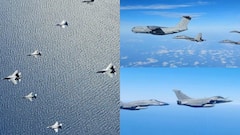India Moving Towards Theatre Commands, Says Modi As He Commissions 3 Naval Combatants
INS Surat, INS Nilgiri and INS Vaghsheer were commissioned into the Navy on Wednesday in an unprecedented move as India asserts its role as a crucial security partner in the Indo-Pacific.

Indian Navy-Theatre Commands: For the first time in India’s naval history, three frontline naval combatants — INS Nilgiri, INS Surat and INS Vaghsheer — were commissioned into the Indian Navy at once on Wednesday, as India asserts its role as a crucial security partner under the Indo-Pacific strategic framework. Commissioning the three platforms, Prime Minister Narendra Modi said the move is part of the defence reforms the government has been unveiling. The reforms, among other things, also envisage the creation of military theatre commands.
This is the first time in his third term as Prime Minister that Modi has spoken about the controversial subject of theaterisation — a move that the ruling BJP has pledged in its election manifesto but not been able to fulfil due to major pushback from the armed forces.
“India is safeguarding its interests everywhere, be it land, water, air, the deep sea or infinite space. This is why India is undertaking reforms relentlessly. The creation of the post of Chief of Defence Staff was one such reform. India is now progressing towards the implementation of theatre commands to make the armed forces more efficient,” Modi said while commissioning the three platforms at Mumbai’s Naval Dockyard Wednesday.
India, Modi added, is today “recognised as a reliable and responsible partner globally, especially in the Global South”. “India operates with a spirit of development, not expansionism. India has always supported an open, secure, inclusive, and prosperous Indo-Pacific Region,” he said.
The three platforms commissioned on Wednesday are expected to boost the Navy’s strength in the seas, especially in the highly contested Indian Ocean Region.
“In shaping global security, economics and geopolitical dynamics, a maritime nation like India is going to play a huge role. For economic progress and energy security, it is important that territorial waters are protected, freedom of navigation is ensured, and trade supply lines and sea routes are secure. We have to protect this entire region from terrorism, arms and drug smuggling,” added Modi.
ALSO READ | US, India Collaborate On Anti-Submarine Warfare Sonobuoys As Threats From China Increase
About The Cutting-Edge Combatants
The INS Surat is the fourth and final ship of the Navy’s guided missile destroyer project. The warship has an indigenous content of 75%, and is equipped with state-of-the-art weapon-sensor packages and advanced network-centric capabilities.
The INS Nilgiri is the first ship of the Project-17A stealth frigate class. It has been designed by the Indian Navy’s Warship Design Bureau, and incorporates advanced features for enhanced survivability, seakeeping, and stealth, reflecting the next generation of indigenous frigates.
Both Surat and Nilgiri have gun mounts and modules to launch the BrahMos supersonic surface-to-surface missiles.
The INS Vaghsheer, the sixth and final submarine of Project-75, was constructed in collaboration with the Naval Group of France under full transfer of technology.
All three platforms, which have been manufactured by Mazagon Dock Shipbuilders Ltd (MDL), can be deployed for missions with immediate effect.
Defence Minister Rajnath Singh, who was also present at the event, said, “Although the Indian Ocean Region has always been important from a geostrategic and economic point of view, in today's rapidly changing environment, it has become even more important. We can say that the importance that the Atlantic Ocean used to have in the past has shifted to the Indian Ocean today.”
Chief of Navy Staff Admiral Dinesh K. Tripathi said these three platforms will make the Indian Navy’s capabilities “more robust and effective in safeguarding India’s maritime interests”.
Equipped with modern aviation facilities, Nilgiri and Surat can operate a range of helicopters, including Chetak, ALH, Sea King, and the newly inducted MH-60R, during both day and night operations.
Vaghsheer is a diesel-electric submarine designed to undertake a wide range of missions, including anti-surface warfare, anti-submarine warfare, intelligence gathering, area surveillance, and special operations.
Armed with wire-guided torpedoes, anti-ship missiles, and advanced sonar systems, the submarine also features modular construction, allowing for future upgrades such as the integration of Air Independent Propulsion (AIP) technology.





































